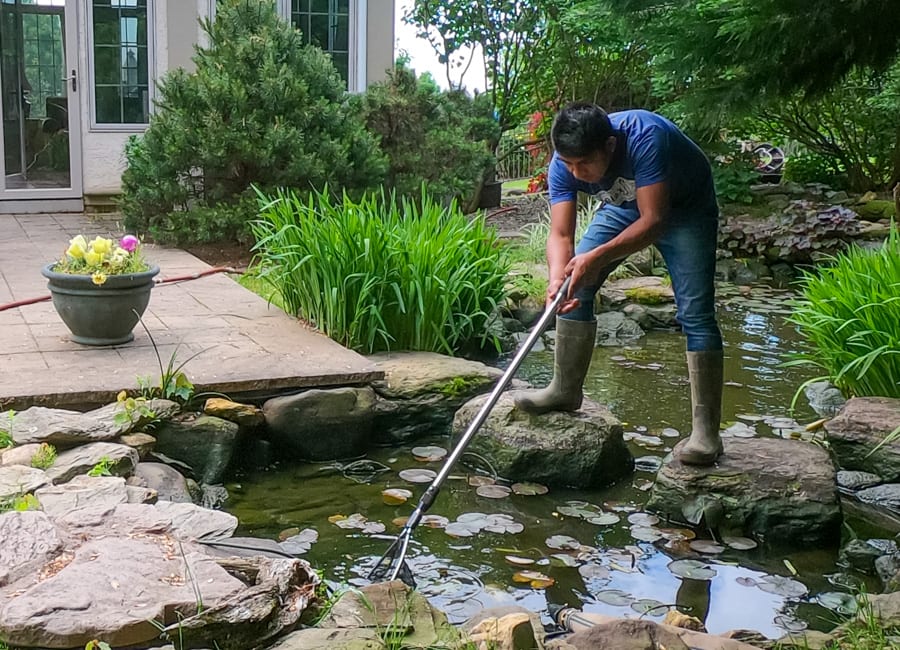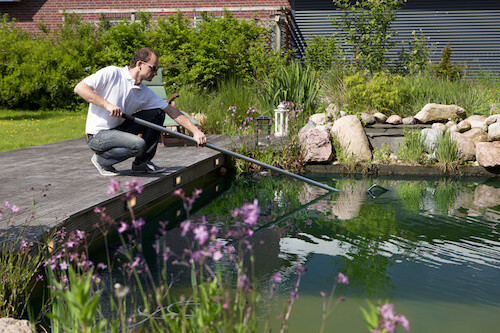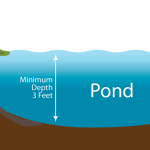If you have a beautiful pond in your garden, keeping it clean and healthy is essential for the well-being of the aquatic life and overall aesthetics. Regular pond maintenance helps to prevent the build-up of algae, debris, and other contaminants that can harm the ecosystem. In this comprehensive guide, we will walk you through the step-by-step process of cleaning your pond to maintain its pristine condition.
1. Assess the Pond Condition
Before diving into the cleaning process, it’s important to assess the current state of your pond. Look for signs of algae overgrowth, debris accumulation, and water discoloration. This initial inspection will help you determine the extent of cleaning required.

Credit: www.youtube.com
2. Remove Debris
Start by removing any visible debris such as leaves, twigs, and branches from the surface of the water. A skimmer net or pond vacuum can be used to effectively clear out the floating debris. This step prevents organic matter from decaying and releasing harmful substances into the water.
3. Trim and Prune Plants
Trim and prune any overgrown aquatic plants to maintain a balanced ecosystem within the pond. Remove dead or decaying foliage to prevent nutrient build-up and promote healthy plant growth. This also enhances the overall appearance of the pond.
4. Check the Filtration System
Inspect the pond’s filtration system to ensure that it is functioning optimally. Clean or replace the filter pads as needed to maintain efficient water circulation and remove impurities. A well-maintained filtration system is crucial for a clean and healthy pond environment.
5. Test and Treat the Water
Use a water testing kit to check the pH, ammonia levels, and other water parameters. Based on the test results, treat the water with appropriate pond treatments to balance the chemical composition and inhibit algae growth. This step helps to create a favorable environment for fish and plants.

Credit: splashsupplyco.com
6. Partial Water Change
Perform a partial water change by siphoning out a portion of the pond water and replacing it with fresh, dechlorinated water. This helps to dilute any accumulated pollutants and maintain water clarity. Be sure to use a de-chlorinator to neutralize chlorine in the tap water.
7. Clean the Pond Liner
Gently scrub the pond liner or walls using a soft brush to remove algae and mineral deposits. Avoid using harsh chemicals that can harm aquatic life. Rinse the liner thoroughly to remove any residual debris and ensure a clean surface.
8. Consider Beneficial Bacteria
Introduce beneficial bacteria into the pond to aid in the breakdown of organic matter and reduce nutrient levels. These natural bacteria help to maintain water quality and minimize the accumulation of sludge at the bottom of the pond, promoting a healthier ecosystem.
9. Monitor and Maintain
Regular monitoring and maintenance are key to keeping your pond in top condition. Keep an eye on water clarity, plant growth, and fish behavior. Address any issues promptly to prevent them from escalating and impacting the overall health of the pond.
So these are the steps that how you can clean a pond. And this is how you can also clean your koi pond.
Frequently Asked Questions
Q: How often should I clean my pond?
A: Cleaning frequency depends on factors like pond size, fish load, and surrounding environment. Generally, a thorough cleaning is recommended annually, with routine maintenance throughout the year.
Q: What tools do I need to clean my pond?
A: Essential tools include a pond vacuum or net, a skimmer or pond rake, a water pump, a bucket, and a hose. Protective gear like gloves may also be useful.
Q: How do I remove debris from the pond surface?
A: Use a skimmer or pond rake to remove leaves, twigs, and other debris from the water’s surface. Alternatively, you can use a net to scoop out larger debris.
Q: Can I use a pond vacuum to clean the bottom of the pond?
A: Yes, a pond vacuum is an effective tool for removing sludge, sediment, and debris from the bottom of the pond. Follow the manufacturer’s instructions for proper use.
Q: How do I clean the pond filter?
A: Turn off the pump and remove the filter media. Rinse the media with pond water to remove debris and buildup. Avoid using tap water, as it can kill beneficial bacteria.
Q: Do I need to drain the pond completely to clean it?
A: In most cases, you don’t need to drain the entire pond to clean it. Partially draining the pond may be necessary for deep cleaning or major maintenance tasks.
Q: How do I clean algae from the pond?
A: Use a pond brush or scrubber to remove algae from rocks, liners, and other surfaces. Adding beneficial bacteria or algae treatments can also help control algae growth.
Final Words
By following these essential steps for pond cleaning, you can ensure that your pond remains a thriving and picturesque feature in your outdoor space. Regular care and attention will contribute to a balanced ecosystem, vibrant plant life, and happy aquatic inhabitants. Take pride in your clean and beautiful pond!





